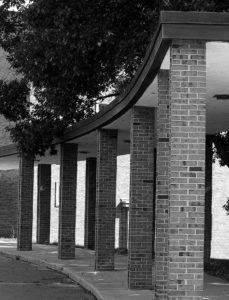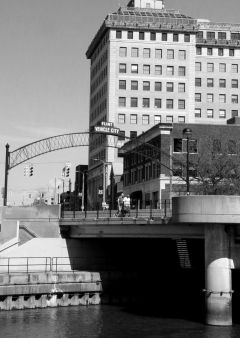
Photo by Edwin D. Custer
By Jan Worth-Nelson
Woodside Church, designed by internationally-known Finnish architect Eero Saarinen and built by his brother-in-law Robert F. Swanson in 1952, has been put up for sale by the congregation, who voted on it at an Oct. 30 congregational meeting.
A press release issued Tuesday said the congregation is beginning its search for a new home and “expects to invest itself more deeply in what the church stands for.”
Rev. Dr. Deborah Conrad, senior minister of the College Cultural neighborhood landmark since February, 2014, said the action was “a first step toward establishing a new home and focusing its efforts and resources on the needs of the broader community.” The church is located at 1509 E. Court St.
She characterized the congregation’s decision as occurring in “a time of growth,” bringing in 15 new members just last month. She noted the church has long been known for its “progressive theology and social activism.”
Karen Eaton, the congregation’s moderator — the equivalent of a president of a congregation — said, “It has been a wonderful home for many years; but, with a heritage of over 160 years dedicated to social justice, we must ensure our resources can be fully devoted to our mission.”
Donald Harbin, a College Cultural neighborhood resident and member of Woodside since 1994 with his wife Elizabeth Perkins-Harbin, served on a committee that spent the last year pursuing options for the church.
“As a group we concluded that the only option for the church to survive was to downsize and sell the beautiful building that we all love. ‘Mission over mansion’ as we like to say,” Harbin said.
The church currently has about 120 members and an attendance of about 70 on Sundays, Conrad said — considered a “stable small congregation” in denominational circles.
Noting that the structure was originally designed for a congregation of 600 or more, Harbin said building maintenance, utilities and general expenses “were consuming a large portion of finances on our small congregation, forcing our mission to take a back seat throughout the year.”
“As a congregation we hope to remain in the city center,” Harbin wrote, “but our path is yet to unfold.
“Liz and I are both architecture freaks,” he added, “so we will miss the calm feeling that we get at services held in the sanctuary. We hope that whoever buys the building will maintain the integrity of the architecture, but there are no guarantees. In the end the people are the church and we love the people of Woodside Church.”
The congregation first assembled itself in 1837, according to a historical marker in the church’s front yard. According to details provided this week by the church, the congregation coalesced in the 1850s. It first met in the courthouse and then in a small room over what was known as “the Scotch store” on Saginaw Street.
The Court Street location was the congregation’s third of what was originally known as the First Baptist Church of Flint. The first official building was at the corner of First Avenue and Lyon Street; the second, at the corner of Beach and Second streets.
After the 1952 move to the current building, the congregation opted to join the Congregational Christian Church denomination, and in 1961 changed its name to Woodside Church. It is a member of two denominations — the United Church of Christ and the American Baptist Church and still bears the legal name of “First Baptist Church.”
Woodside was a stop on the Underground Railroad during the Civil War; an advocate for fair housing, civil rights, and an end to Jim Crow in the 1950s. In recent years the congregation has “ruffled feathers,” Conrad said, “over its welcome of people who are gay, lesbian, bisexual and transgender” and acting as “a catalyst for examination of policies of mass incarceration, poverty and water rights.”
“Woodside will never abandon our brothers and sisters most likely to be marginalized and targeted by oppressive social policies and politics,” Conrad said.

Deborah Conrad, Woodside minister since 2014
“We have been very at home in the CCN — this isn’t us trying to get out of the neighborhood,” she noted in a follow-up interview. “We have a mission that we care about. Caring for a building has required too much attention, and caring for the mission has taken a back seat. We realized we could do more. This is partly about setting financial priorities and partly about the passion of our folks and how the church has changed.”
“We are merely selling a building,” Conrad said. “We are not losing our voice. We will continue to be the church.”
East Village Magazine photographer and board president Edwin D. Custer, a long time resident, homeowner, landlord and neighborhood activist in Central Park near Woodside, has taken many photos of the landmark — including the one reprinted here — consistently noted as one of the most architecturally important buildings in Flint.
For Custer, the building means more than its famous architect.
“Woodside Church holds a special meaning for me,” Custer said. “In my youth in the 1950’s it was the place Gary [Custer, Ed’s brother and late long-time publisher of EVM] and I were baptized (full immersion) , attended services and the youth group classes, had sock hops in the basement, where I sang (poorly) in the choir, and where I fell asleep during every candle-lit Christmas Eve service with my mom poking me to stay awake.”
In reporting on their decision, church leaders quoted one of the church’s pastors from the 1940s, Rev. Dr. Franklin Elmer, who said, “Woodside is not a spectator church. For those who do not wish to become involved in the difficult issues confronting our contemporary world, or for those who do not wish to be disturbed about their own condition or the general state of the world, this is an impossible church.
“Participation means more than attending worship services,” Elmer said. “It means joining in on the adventurous and exciting process of life itself.”
Conrad said the congregation has “no idea yet of where we’re going to go — no clue yet. A lot of people are very emotionally involved about where. We’re going to make sure the congregation is really involved — it’s just the beginning of the process. We’re going to work together and work it out.”
Conrad said the conversation about moving has been ongoing for years.
“Unlike other 160-year-old congregations, because of our history, we’re not bound to a place,” she said.
When Conrad came to Woodside two and a half years ago, she said it was not long before it became clear a move was “something we were going to tackle…the process for us has been a really healthy one.”
“We are not dying,” she said. Rather, she said, the congregation is devoted to the concept of “tikkun olam,” a Hebrew phrase for “world repair.”
She noted the growing effect of the millenial generation, who, she said, “care a great deal about social justice and the common good instead of the common purse serving institutions. They are trying to make the world better.”
“Woodside has this mindset more than any other church I’ve ever served,” she said.
EVM Editor Jan Worth-Nelson can be reached at janworth1118@gmail.com.


You must be logged in to post a comment.